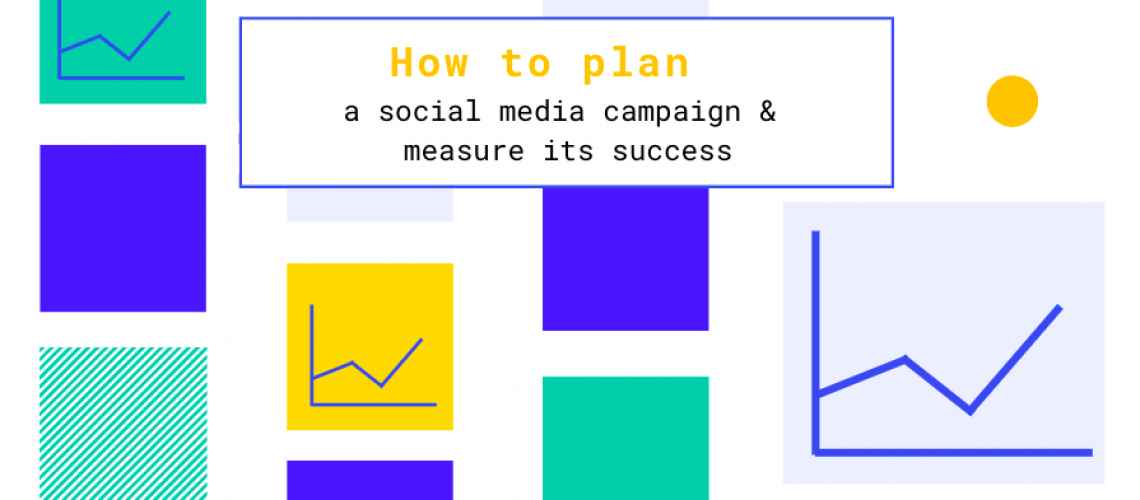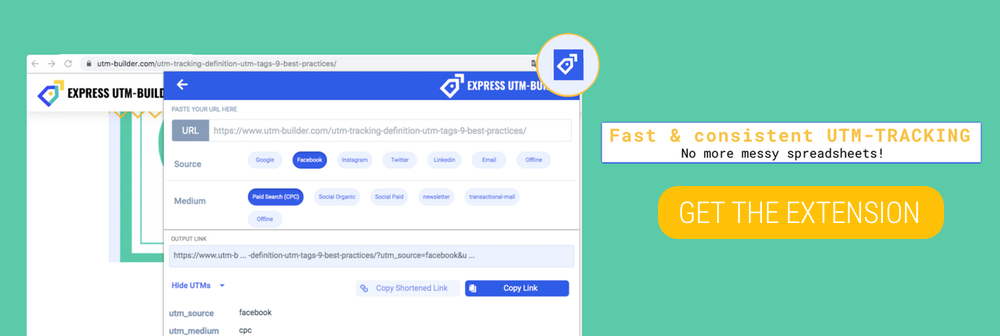Remember when social media was all about cute cat pictures and FarmVille crops? Yeah, me neither! What started as an online space for personal conversations and amateur entertainment is now a huge marketplace with endless advertising opportunities. Social media platforms have quickly become influential media outlets with an extraordinary reach. Every brand wants to be part of this, and a lot of them invest time and money in the campaigns they run on social. If your brand is one of them, don’t start unprepared – social media campaigns need professional planning. When you plan a campaign with clear goals and measure and analyse the data in the right way, you’ll have greater control over your campaign and much better success with it. While this sounds very serious, it doesn’t mean the playfulness that we all enjoy on our personal accounts is ruled out – the posts you put up can be as fun and playful as you like, but you can do it in a way that’s backed up by data and so get the results you want.
Goals and objectives for social media - when you know what you want to achieve, you know what to measure
Let’s start with goals and objectives, the basis for any social media campaign. First, it’s important to distinguish between the two concepts. Goal is the “what” of what you want to achieve – generally speaking, it’s broad and describes the direction you want to take in the long term. The goal of your social media campaign could be for instance to create more engagement, to get your followers to interact with your content more. If your goal tells you what you are going after, objectives tell you how to get it. They’re the concrete, tangible steps to get you where you want to be. If your goal is to increase engagement, then your objectives could be posting content that invites your followers to get involved – organising competitions, for example.
Social Media Campaign Goals
There are a few things to keep in mind when deciding your goals and the strategies to take you there. A useful way of approaching this is to use the SMART framework. SMART goals are specific, measurable, attainable, relevant and time-bound. Let’s look at those in a bit more detail.
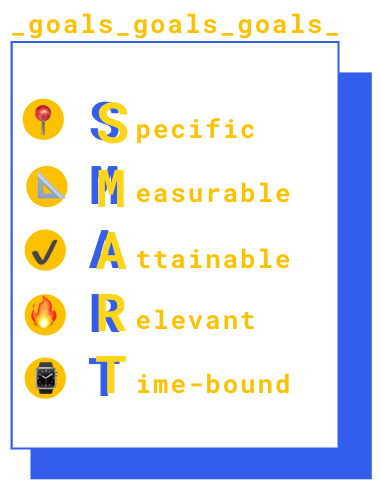
The first thing to note is that the goal needs to be specific, clearly stated and understandable. This helps you to formulate your objectives. Your goal should also be measurable – with quantified objectives, you’ll see if you’re making progress and getting closer to your goal. You also need to consider how attainable your goal is. What’s realistic for you to achieve? What enables you to achieve it, and what might be an obstacle? You should also consider if what you want is relevant to you. Does it make sense in terms of your overall business goals? Is it what your target audience is interested in? Finally, time-bound goals: think about the timeframe for the campaign. How will you track progress from your starting point to the end of the campaign?
It’s important to consider these questions prior to starting your social media campaign. It helps you to design your campaign in such a way that it’s easy to track your progress, as well as measure and analyse results. This also ensures that your expectations match the reality of the campaign. Going forward, this’ll empower you to make data-driven decisions and get more out of social media.
Stages of the social media funnel - where you are now will help you get where you want to go
You could say that your goals determine your objectives. What determines your goals then? Your goals depend on where you currently are with your brand’s social media. A helpful way to approach this is to look at the social media funnel: a visual guide to the buyer’s journey on social media. The social media funnel maps the different stages of establishing a relationship with your audience, leading up to driving conversions. It also helps you to share insights between different teams and to get them involved in social media campaigns: marketing, PR, performance marketing, to give a few examples. The stage you are in will guide you to find reachable goals that then help you to develop your social media presence further.
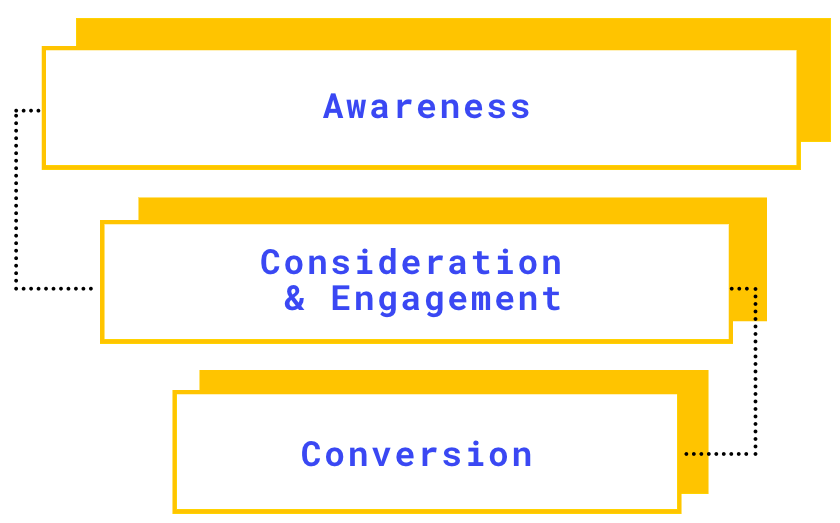
Awareness Stage: Let them get to know you
There are three stages in the social media funnel: awareness, consideration & engagement, and decision. Looking at the stages from the buyer’s point of view, the first stage is where they first encounter the product, first hear about it. When you start out, you’ll want to create awareness for your brand. You introduce yourself: you’ll want to pique the public’s interest and start growing your audience. To illustrate this point, let’s take sustainable kids’ shoes as an example. How would you build awareness of this brand new product? To gain followers, you could create a heartfelt campaign that highlights the sustainability of your product and the importance of environmentally sound decisions made now to the future generations to gain the interest of your potential audience.
consideration & engagement Stage: Give them more details & interact
In the next stage, consideration & engagement, your potential customers take your product into account in their decision-making process. They’re looking at different options and weighing them against each other to see what would best suit their needs. By now, your followers are already familiar with your brand, so you’ll want to create demand. You could do this by increasing engagement with your followers. While campaigns focusing on awareness often are emotional in tone, campaigns for more engagement tend to go for more solid information, like pricing or qualities of the product. When you want more engagement with your followers, you could make a post so funny that people want to share it. You can also ask questions to start a conversation, or showcase two of your products and ask your audience to pick their favourite. Which colour or style of shoes do your followers prefer for their offspring to run around in? You can also create a hashtag that your followers can use for their own posts, making them a part of your brand while the pictures and videos of your product in use spread to your followers’ followers.
Conversion Stage: Make them your customer
The third stage of the social media funnel, decision, is where conversions happen – where your social media followers decide to become your customers. Conversions aren’t limited to making a purchase, though. While in marketing a conversion often means that potential customers become buyers, in social media a conversion could be more than a sale. Subscribing to your newsletter can be a conversion, as well as the download of a white paper. It all relates back to the goals you set at the beginning of the campaign, and stage of the social media funnel your target users are in. When your goal is conversion and you plan a campaign based on it, a good objective to match this is to make posts with call-to-action links, where you encourage your followers to perhaps purchase your product, subscribe to your newsletter, or download your white paper. The important thing to note is that once the conversion happens, whatever form it takes, the user browsing your social media site leaves it and lands on your website or online shop. The journey that started on Facebook, Instagram or Twitter (or any other social media platform you’re using) now finishes on your own site.
You could also expand the social media funnel beyond conversion to advocacy, where you have loyal followers and customers who’ll recommend your brand to others too. There’s a lot you can look into, but once you’re able to identify what stage of the social media funnel you are at, coming up with suitable, realistic goals becomes easier. With that, planning a campaign that fits exactly where you are follows naturally, taking you to the next stage.
Social media campaign metrics: The KPIs for your goals
Once you’re clear on your goals and objectives, the next thing to focus on is making sure you get there! When you make your social media campaign measurable, you’ll see exactly what is going well and where you could improve. You’ll get more out of your campaign when you track your progress and measure the results. KPIs, key performance indicators, are there precisely for that. A KPI is a metric measuring performance in different aspects of your business. For different types of objectives you’ll need to look at different KPIs, and part of the planning process is identifying the KPIs that are best suited to track what’s important to you. There are countless KPIs, and the ones mentioned here are just a few examples to give you an idea of the type of data you can use to measure your social media campaigns.
Native Insights vs. Analytics INsights via UTM
So where do you actually get the numbers? For KPIs regarding awareness and engagement, in other words how well your brand is known on social media and how much your audience interacts with you, native platform analytics tell you what you need to know. Insights on Facebook, for instance, give you the details on impressions and reach, but other platforms have their own section for this type of data too. What it’s called – whether is “Insights” like on Facebook or “Analytics” like on Pinterest – and how it’s presented varies from platform to platform. For this reason, however, comparing data from different platforms is tricky, as not only the format of the data is different, but it is also measured differently to begin with. And so, native platform analytics aren’t much use to you in a cross-platform approach, in other words when you are interested in seeing which of your platforms is the most successful with the same campaign. For a cross-platform analysis, UTM parameters are a much better tool, as they give you data from different platforms in the same place and same format, and we’ll talk about them a bit more later on.
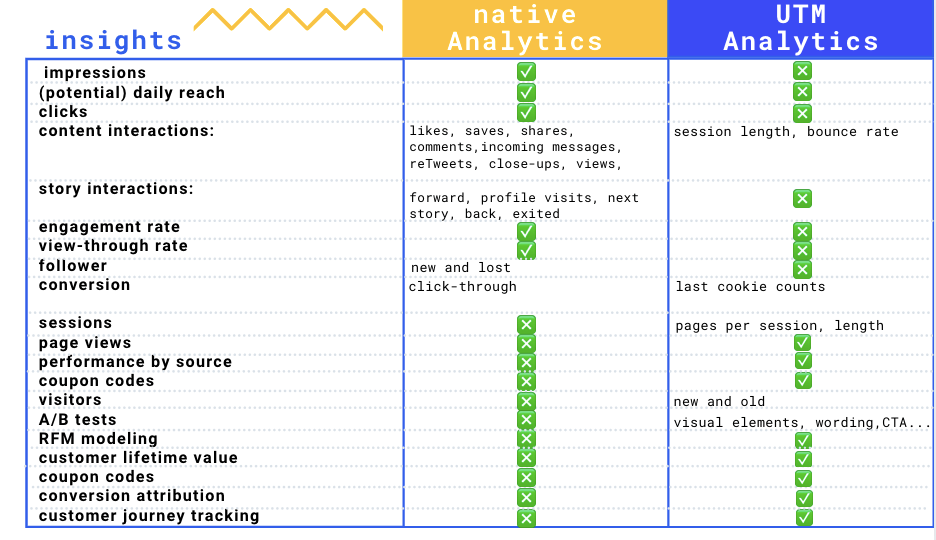
For an analysis of one platform over time, native analytics are great sources of data (in fact, some KPIs can only be measured using native platform analytics, such as impressions on Facebook). Out of all the KPIs you could utilise, some can indeed be as straight-forward as the number of impressions, how many times your post pops up on a viewer’s screen. You’ll get this directly from the platform itself, and all you need to do is to keep track of it. Other types of KPIs might require you to do a bit of maths yourself, for instance if you want to find out what rate your audience is growing. When it comes to the number of your followers or likes, comments and shares your posts are getting, you’ll get the metrics needed to calculate KPIs directly from the platforms themselves, and the rest is up to you. The main thing to remember is choosing your KPIs depends entirely on the goals you have for your campaign.
When it comes to metrics such as click-through rate, you’ll get the data directly from the platform you’re using. Social media sites provide data on conversions too, although each platform has their own way of doing this. The data might be presented in a manner that’s favourable to them – to convince you that their site is better for your brand than those of their competitors. What this means for the measurable campaign you are planning, is that you won’t be able to accurately conduct a cross-platform analysis of conversion rate when the data you get is gathered by different means by different sites. This isn’t to say that you wouldn’t be able to track these things reliably and objectively, though. Conversions are an important part of your business, and especially if your campaign aims for more conversions, undoubtedly you’ll want to have as much data on that as possible. This is where UTM links come in. In short, here’s what UTM parameters can tell you: what platform the content is posted (source), whether it’s organic or paid (medium), and what it’s about, for example the sustainable kids’ shoes (campaign). What makes the difference here is that not only do you have all the data you need in one place, it’s also measured in the same way, making cross-platform analysis much, much easier. If you’re new to UTM links and want to learn more, have a look at the article here.
Want to learn the basics of UTM Tracking?
UTM Parameter for social media - Examples
When you’re creating your UTM links, one of the most important things is consistency. Otherwise, it’s up to you which tags to use for your links. Think about what is the most important data for you in terms of tracking the campaign’s progress. This all goes all the way back to your goals and objectives: what do you want from social media, what’s the most important thing to you? When you’re clear on this from the start, analysing and measuring data becomes a lot simpler. With UTM links, you’ll have data from various platforms in one place, in the same format, which makes it easy to track and analyse. What’s more, you can keep track of not only new business, but your spending as well – with metrics such as cost-per-click, you know how much you’re spending on ads and sponsored posts.
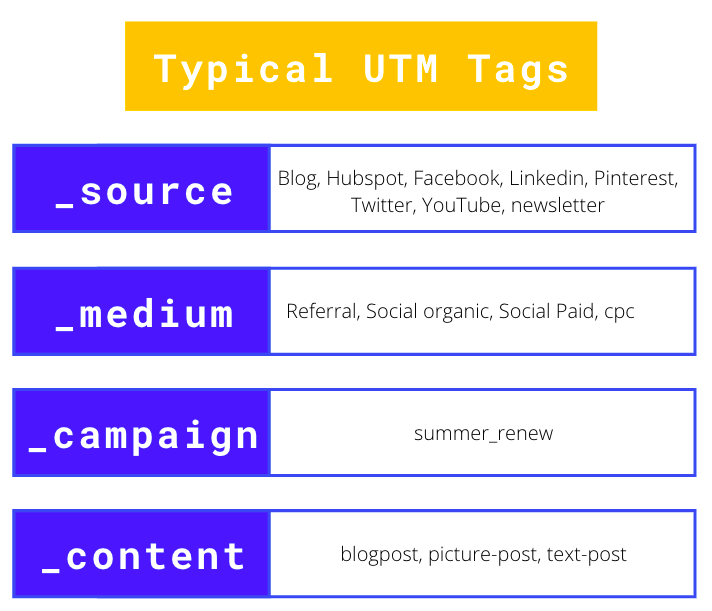
Prior to starting your campaign, you might want to do a bit of testing to get the most out of your campaign, particularly if you have a budget. A/B testing allows you to change variables and compare results. The variable could be anything: image, caption, platform, time, content type…(we wrote a whole article on Pinterest UTMs & what to compare on this super visual platform) If you have two images, and want to know which one of them is more appealing, simply post them both with the same caption, and see which one of them gets more clicks, for instance. To get accurate, reliable results you can plan your tests in the same way you would plan your campaign, keeping in mind your goals and objectives as well as the KPIs that measure them. You can use UTM links in A/B testing as well, and this allows you to see exactly what is the type of content that your customers are clicking on – in other words, when you’re ready to invest money in your social media campaign, you’ll know exactly what convinces your followers to sign up for your newsletter, read your blogpost or buy your product, whatever the goal is.
valuation of your social media campaign: Has it been successful?
At the end of the campaign, you’ll want to know if you got what you wanted, and especially if you invested financially in your campaign, was the return on that investment what you were looking for. This is when the importance of measurable objectives becomes clear. Data from both native platform analytics as well as UTM links will show you what you’ve achieved in the campaign.
When you look at the results of the campaign, you are looking at the return on investment, ROI. Both your investment and its pay-off may be monetary, but they don’t have to be. How much you spend on your campaign in terms of money, but also the hours of work you put in to plan and execute the social media campaign are all part of your investment. As for the return, it could be the sales you’ll make, but it can be non-tangible as well: a wider follower base, more engagement with your audience, sign-ups to newsletters. In short, this all depends on the goals you set for the campaign. Final analysis of the campaign against the goals you set in the beginning will help you plan for your future campaigns, and also shows the importance of social media. With plenty of data-driven information about the performance of your brand, it’s a vital part of your business that can contribute to it in a unique way.
Let us know what your obstacles are while planning a social media campaign that is measurable and which KPI is your favourite to measure success.

